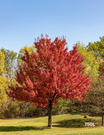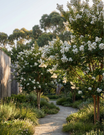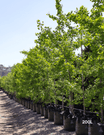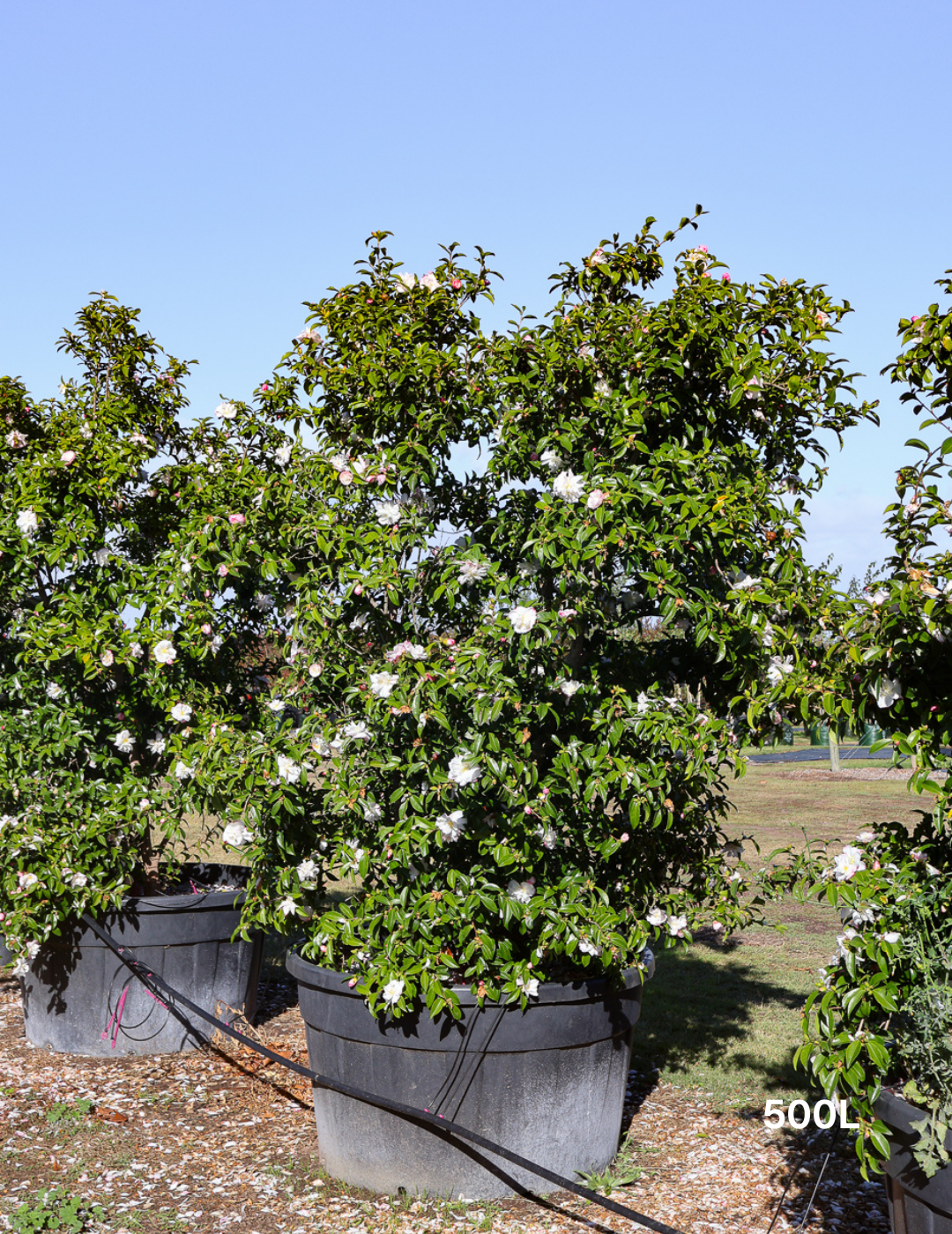Creating a green roof or vertical garden using trees is a trend in modern architecture and a powerful way to transform your property into an eco-friendly, stunning, and vibrant sanctuary. For those with discerning tastes and an eye for beauty and practicality, incorporating trees into vertical gardening designs brings an element of subtle luxury, all while improving air quality, providing shade, and enhancing biodiversity. Choosing the right trees is key if you’re looking to create a rooftop oasis or living wall that exudes elegance and sophistication.
In this guide, we’ll explore how to select the perfect trees for green roofs and walls, focusing on varieties that thrive in Australia’s unique climate. We'll discuss the stunning Camellia sasanqua, the versatile Tristaniopsis laurina, and more to help you make informed decisions for your high-end garden design.
Why Use Trees in Vertical Gardening?
Trees are often overlooked in vertical gardening due to their size, but they can be transformative when used creatively. Whether aiming for a serene, natural look or something bold and contemporary, trees bring structure, height, and depth to a green wall or roof garden that other plants simply can’t.
Key Benefits:
- Enhanced Aesthetics: Trees add a sense of grandeur and elegance to any vertical garden. Their natural form creates a visually striking contrast with artificial structures.
- Sustainability: Trees improve air quality, reduce heat island effects in urban areas, and support local wildlife.
- Privacy & Shade: Taller trees can offer privacy from neighboring buildings and shade from the harsh Australian sun, adding comfort and style.
- Year-Round Interest: Many evergreen trees maintain their foliage throughout the year, ensuring your garden looks lush and vibrant even in winter.
Best Trees for Vertical Gardens in Australia
When designing a vertical garden or green roof, choosing trees well-suited to the local climate, offering year-round interest, and requiring relatively low maintenance is essential. Here are three standout species:
1. Camellia sasanqua (Setsugekka Camellia)
Camellia sasanqua 'Setsugekka', commonly known as the Setsugekka Camellia, is a beloved cultivar prized for its beautiful, ruffled white flowers that appear in abundance during the cooler months of autumn and winter. This evergreen shrub is part of the Theaceae family and is native to Japan. Its glossy, dark green foliage and elegant, slightly fragrant blooms serve as a stunning focal point in any garden setting.
- Height: Up to 4 meters
- Features: Glossy, dark green leaves and delicate blooms ranging from white to pink and red, flowering in late autumn and winter.
- Growing Conditions: Prefers well-drained, slightly acidic soil and partial shade, though it can tolerate full sun in cooler areas.
- Why it Works: Its compact size and non-invasive roots make it perfect for containers on a rooftop garden or as a focal point in a vertical design. The tree’s subtle beauty adds a touch of elegance and calm.
2. Tristaniopsis laurina (Water Gum)
A native Australian tree, Tristaniopsis laurina is renowned for its resilience, beauty, and adaptability, making it an excellent choice for vertical gardening. This evergreen species is perfect for rooftop gardens or vertical walls, thanks to its slim, upright growth and moderate height.
- Height: It typically grows between 6 and 10 meters but can be pruned to maintain a more manageable size.
- Features: It has glossy green leaves and vibrant yellow flowers that bloom in spring and summer. Its smooth, mottled bark adds visual interest throughout the year.
- Growing Conditions: Thrives in full sun to partial shade and can tolerate a range of soil types, though it prefers moist, well-drained soil.
- Why it Works: Its tolerance for varying conditions and architectural form make it ideal for modern garden designs. Tristaniopsis laurina provides shade and visual interest, perfect for creating a serene, natural ambiance in an urban setting.
3. Magnolia grandiflora ‘Little Gem’
For those looking to introduce a touch of timeless elegance to their green wall or rooftop garden, the Magnolia grandiflora ‘Little Gem’ is an excellent choice. This dwarf variety of the classic magnolia offers all the beauty of the larger species, with glossy, evergreen leaves and stunning white flowers.
- Height: Reaches up to 3-4 meters, ideal for vertical planting.
- Features: Large, creamy white flowers that bloom in late spring and summer, along with rich, dark green leaves that are bronze underneath.
- Growing Conditions: Prefers full sun to part shade and well-drained soil. It can tolerate various conditions but thrives best with regular watering during dry periods.
- Why it Works: The Magnolia' Little Gem' 's compact size and refined beauty make it a fantastic option for small spaces. Its evergreen foliage and dramatic blooms bring luxury to any green wall or roof garden year-round.
Tips for Successful Tree Integration in Vertical Gardens
Incorporating trees into a green roof or wall requires careful planning. Here are some essential tips to ensure your trees thrive in a vertical setting:
1. Choose Trees with Non-Invasive Root Systems
Trees with deep, spreading roots may damage the structure of a green roof or wall. Opt for species like Camellia sasanqua, Tristaniopsis laurina, and Magnolia grandiflora ‘Little Gem,’ which have compact or non-invasive root systems well-suited for confined spaces.
2. Consider Weight and Structure
When planting trees on a roof, ensure the building can support the additional weight. Use lightweight planting mediums and containers designed for rooftop gardening. If you're incorporating larger trees, consult with a structural engineer.
3. Use Planters and Vertical Frameworks
Trees in vertical gardens typically need planters or trellises for support. Choose containers that complement the overall design and ensure proper drainage. For green walls, you can install a vertical framework or trellis to guide the tree’s growth, ensuring it remains upright and secure.
4. Watering and Irrigation
Regular watering is crucial for trees growing in containers or on walls. Drip irrigation systems are ideal for ensuring consistent moisture levels without overwatering, which can lead to root rot. For a green roof, ensure that your irrigation system is tailored to the specific needs of your tree species.
5. Prune Regularly
Keep your trees healthy and maintain the desired size by pruning regularly. This will promote better air circulation and light penetration and ensure your green wall or roof maintains a sleek, manicured look.
FAQs
Q: What trees are best suited for small rooftop gardens?
A: Trees like Camellia sasanqua, Tristaniopsis laurina, and Magnolia grandiflora ‘Little Gem’ are ideal for small spaces due to their compact growth and non-invasive root systems.
Q: How do I maintain trees on a green roof?
A: Regular pruning, adequate irrigation, and choosing lightweight planters will help maintain the health of trees on a green roof. Monitoring the tree’s growth and adjusting care as needed is essential.
Q: Can I plant evergreen trees on a green wall?
A: Evergreen trees like Camellia sasanqua and Magnolia grandiflora ‘Little Gem’ can be incorporated into green walls, providing year-round foliage and aesthetic appeal.
Incorporating trees into your green roof or wall design is an elegant way to elevate your property’s beauty while making a positive environmental impact. With the right species selection and thoughtful planning, you can create a lush, thriving oasis that enhances your home's architecture and the natural beauty of your surroundings.




















































Leave a comment
This site is protected by hCaptcha and the hCaptcha Privacy Policy and Terms of Service apply.